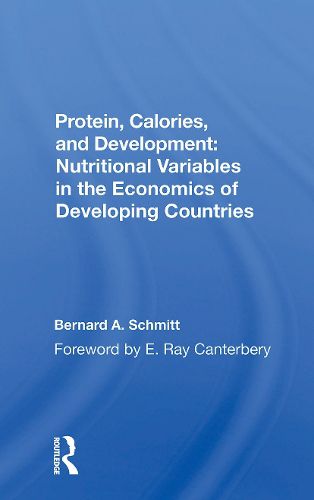Readings Newsletter
Become a Readings Member to make your shopping experience even easier.
Sign in or sign up for free!
You’re not far away from qualifying for FREE standard shipping within Australia
You’ve qualified for FREE standard shipping within Australia
The cart is loading…






Production of world food supplies is related to more complicated socioeconomic variables than have previously been analyzed. Besides traditional inputs of land, labor, and fertilizer, the technological capabilities and a variety of nutritional and other human capital components are significant independent variables in explaining agricultural production in the developing world. The integration of economic analyses with the concepts of nutritional science offers an expanded and effective means for analyzing the complex problems of agricultural production in nutritionally deficient countries. Bernard Schmitt traces the circular relationship between nutrition and human capital, labor productivity, food production, and per capita consumption of calories and protein. He defines the basic nutritional terms that are most useful to economists in analyzing agricultural and foodrelated questions and provides examples that stress the importance of concentrating on nutritional quality as well as gross quantity. Transformations are used to convert quantities into basic nutritional components, allowing more meaningful quantitative analyses in an econometric framework. Dr. Schmitt presents a flexible methodology for forecasting commodity production, using it to make projections for the developing countries for each major commodity group and to test various policy alternatives such as extensive trade, expanded food assistance programs, substantial resource or input expansion, further expansion of Green Revolution technology, and development of alternatives to agriculture. Although he is certain that gains can be accomplished through population control and agricultural advances, supplemented by alternative nutritional sources, he concludes that conditions in nutritionally deficient countries are unlikely to improve, on average, through the mid-1980s.
$9.00 standard shipping within Australia
FREE standard shipping within Australia for orders over $100.00
Express & International shipping calculated at checkout
Production of world food supplies is related to more complicated socioeconomic variables than have previously been analyzed. Besides traditional inputs of land, labor, and fertilizer, the technological capabilities and a variety of nutritional and other human capital components are significant independent variables in explaining agricultural production in the developing world. The integration of economic analyses with the concepts of nutritional science offers an expanded and effective means for analyzing the complex problems of agricultural production in nutritionally deficient countries. Bernard Schmitt traces the circular relationship between nutrition and human capital, labor productivity, food production, and per capita consumption of calories and protein. He defines the basic nutritional terms that are most useful to economists in analyzing agricultural and foodrelated questions and provides examples that stress the importance of concentrating on nutritional quality as well as gross quantity. Transformations are used to convert quantities into basic nutritional components, allowing more meaningful quantitative analyses in an econometric framework. Dr. Schmitt presents a flexible methodology for forecasting commodity production, using it to make projections for the developing countries for each major commodity group and to test various policy alternatives such as extensive trade, expanded food assistance programs, substantial resource or input expansion, further expansion of Green Revolution technology, and development of alternatives to agriculture. Although he is certain that gains can be accomplished through population control and agricultural advances, supplemented by alternative nutritional sources, he concludes that conditions in nutritionally deficient countries are unlikely to improve, on average, through the mid-1980s.